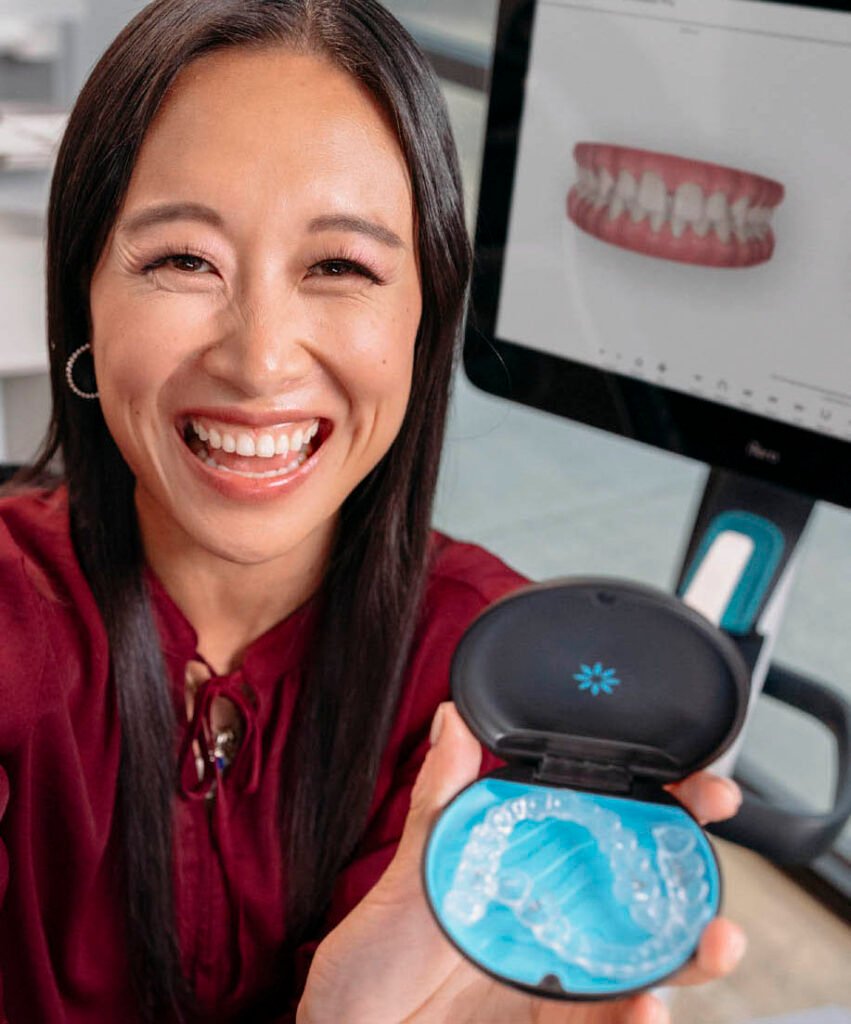Understanding How Clear Aligners Treat Common Bite Issues
Invisalign is widely known for straightening crooked teeth, but many patients wonder: Can it also correct bite problems like overbite, underbite, and crossbite? The answer is yes—Invisalign can effectively treat many bite misalignments, depending on their severity and your individual dental anatomy.
Let’s take a closer look at how Invisalign addresses these conditions, what treatment involves, and what results you can realistically expect.
🦷 What Is a Malocclusion?
A “malocclusion” is a misalignment of the teeth and jaws. When your upper and lower teeth don’t meet properly, it can affect chewing, speech, facial appearance, and long-term oral health. Invisalign is designed to gradually move your teeth and jaws into better alignment using custom-made clear aligners.
✅ 1. Can Invisalign Fix an Overbite?
✔ Yes—In Most Cases
What Is an Overbite?
An overbite (also called a deep bite) occurs when the upper front teeth excessively overlap the lower front teeth. A slight overbite is normal, but a deep one can cause:
- Worn-down front teeth
- Jaw pain
- Speech difficulties
- A “gummy smile” appearance
How Invisalign Helps:
Invisalign aligners can gradually move the upper and lower teeth to reduce the vertical overlap. The treatment may include:
- Tooth movement to reposition the upper front teeth
- Elastic attachments to help shift jaw alignment
- Interproximal reduction (IPR) if necessary to create space
Best for:
- Mild to moderate overbites
- Some severe cases (with attachments or elastics)
✅ 2. Can Invisalign Fix an Underbite?
✔ Yes—In Select Cases
What Is an Underbite?
An underbite occurs when the lower front teeth protrude beyond the upper front teeth. This can lead to:
- Difficulty chewing
- Jaw strain
- Tooth wear and tear
- Facial imbalance
How Invisalign Helps:
Invisalign can move the lower teeth backward and/or the upper teeth forward, using:
- Series of clear aligners
- Attachments (small tooth-colored dots bonded to teeth)
- Rubber bands (for skeletal correction, if applicable)
Limitations:
- Mild to moderate underbites respond well to Invisalign
- Severe skeletal underbites may require a combination of Invisalign and orthognathic surgery
✅ 3. Can Invisalign Fix a Crossbite?
✔ Yes—Most Mild to Moderate Cases
What Is a Crossbite?
A crossbite happens when some upper teeth sit inside the lower teeth when biting down. It can affect:
- One tooth or several teeth
- The front or back of the mouth
Common issues caused:
- Uneven wear on teeth
- Gum recession
- Jaw pain or TMJ problems
- Asymmetrical jaw growth (in children)
How Invisalign Helps:
- Aligners apply gentle pressure to move misaligned teeth outward or inward
- Precision wings or attachments help guide more complex movements
- In some cases, patients may need palatal expanders prior to Invisalign
Ideal for:
- Single-tooth or segmental crossbites
- Posterior (back teeth) or anterior (front teeth) crossbites
⚖️ Invisalign vs. Braces for Bite Correction
| Condition | Invisalign | Traditional Braces |
|---|---|---|
| Overbite | Effective for most cases | Effective for all cases |
| Underbite | Effective in mild to moderate cases | Better for severe skeletal cases |
| Crossbite | Effective for most mild/moderate cases | Highly effective for all types |
Invisalign is especially appealing for adults and teens seeking a less noticeable treatment option. However, very complex skeletal issues may still be best treated with traditional orthodontics or surgical options.
⏱️ How Long Does Invisalign Take to Correct Bite Issues?
- Mild cases: 6–12 months
- Moderate cases: 12–18 months
- Complex cases: 18–24+ months
Your treatment timeline depends on the severity of your bite, how well you follow your wear schedule (20–22 hours/day), and whether you require additional tools like elastics or refinements.
👨⚕️ Is Everyone a Candidate?
Invisalign is a powerful tool, but not every patient is the right candidate for bite correction using clear aligners. A qualified orthodontist or Invisalign provider will assess:
- Your bite type and severity
- Your jaw structure and age
- Previous orthodontic history
- Compliance potential (aligners must be worn consistently)
In some cases, Invisalign may be used in combination with other orthodontic methods or after surgery to fine-tune results.
✨ Final Thoughts
Invisalign can correct many types of bite problems—overbite, underbite, and crossbite—as long as the case is not too severe or skeletal in nature. With proper planning and compliance, it offers a comfortable, discreet, and effective alternative to traditional braces.
If you’re wondering whether Invisalign is right for your bite issue, the best first step is a consultation with an experienced provider. They’ll use digital scans to evaluate your alignment and create a personalized treatment plan tailored to your needs.Invisalign is especially appealing for adults and teens seeking a less noticeable treatment option. However, very complex skeletal issues may still be best treated with traditional orthodontics or surgical options.
⏱️ How Long Does Invisalign Take to Correct Bite Issues?
- Mild cases: 6–12 months
- Moderate cases: 12–18 months
- Complex cases: 18–24+ months
Your treatment timeline depends on the severity of your bite, how well you follow your wear schedule (20–22 hours/day), and whether you require additional tools like elastics or refinements.
👨⚕️ Is Everyone a Candidate?
Invisalign is a powerful tool, but not every patient is the right candidate for bite correction using clear aligners. A qualified orthodontist or Invisalign provider will assess:
- Your bite type and severity
- Your jaw structure and age
- Previous orthodontic history
- Compliance potential (aligners must be worn consistently)
In some cases, Invisalign may be used in combination with other orthodontic methods or after surgery to fine-tune results.
✨ Final Thoughts
Invisalign can correct many types of bite problems—overbite, underbite, and crossbite—as long as the case is not too severe or skeletal in nature. With proper planning and compliance, it offers a comfortable, discreet, and effective alternative to traditional braces.
If you’re wondering whether Invisalign is right for your bite issue, the best first step is a consultation with an experienced provider. They’ll use digital scans to evaluate your alignment and create a personalized treatment plan tailored to your needs.Invisalign is especially appealing for adults and teens seeking a less noticeable treatment option. However, very complex skeletal issues may still be best treated with traditional orthodontics or surgical options.
⏱️ How Long Does Invisalign Take to Correct Bite Issues?
- Mild cases: 6–12 months
- Moderate cases: 12–18 months
- Complex cases: 18–24+ months
Your treatment timeline depends on the severity of your bite, how well you follow your wear schedule (20–22 hours/day), and whether you require additional tools like elastics or refinements.
👨⚕️ Is Everyone a Candidate?
Invisalign is a powerful tool, but not every patient is the right candidate for bite correction using clear aligners. A qualified orthodontist or Invisalign provider will assess:
- Your bite type and severity
- Your jaw structure and age
- Previous orthodontic history
- Compliance potential (aligners must be worn consistently)
In some cases, Invisalign may be used in combination with other orthodontic methods or after surgery to fine-tune results.
✨ Final Thoughts
Invisalign can correct many types of bite problems—overbite, underbite, and crossbite—as long as the case is not too severe or skeletal in nature. With proper planning and compliance, it offers a comfortable, discreet, and effective alternative to traditional braces.
If you’re wondering whether Invisalign is right for your bite issue, the best first step is a consultation with an experienced provider. They’ll use digital scans to evaluate your alignment and create a personalized treatment plan tailored to your needs.




